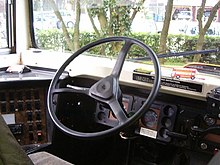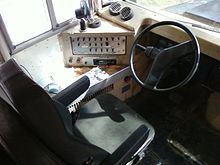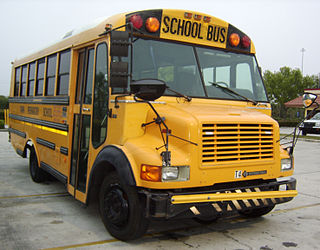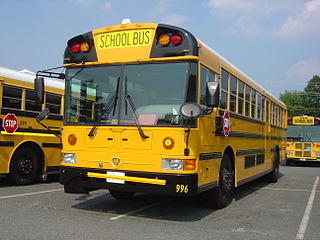This article needs additional citations for verification .(April 2014) (Learn how and when to remove this template message) |
| International S-Series "Schoolmaster" International 3700/3800 | |
|---|---|
| Overview | |
| Production | 1979–2004 |
| Body and chassis | |
| Class | Class 6 |
| Body style(s) | Cowled chassis (conventional) |
| Related | International S Series/International 4000-Series (1989-2001) |
| Chronology | |
| Predecessor | International Harvester Loadstar 1703/1803 |
| Successor | International 3300 (DuraStar) |
The bus chassis variant of the International S-Series is a cowled bus chassis (conventional style) that was produced by International Harvester (later Navistar International) from 1979 to 2004. Produced primarily for school bus applications, the chassis was also produced for other applications, including commercial-use buses and cutaway-cab buses. In addition, the cowled chassis formed the basis for front-engine and rear-engine stripped chassis produced for bus applications.

The International Harvester Company was a United States manufacturer of agricultural machinery, construction equipment, trucks, automobiles, and household and commercial products. Its reorganized successor, after spin-off of several of those businesses, is Navistar International.
Navistar International Corporation is an American holding company, that owns the manufacturer of International brand commercial trucks, IC Bus school and commercial buses, Workhorse brand chassis for motor homes and step vans, and is a private label designer and manufacturer of diesel engines for the pickup truck, van, and SUV markets. The company is also a provider of truck and diesel engine parts and service.
Contents
- First generation (S-Series; 1979–1989)
- Model overview
- Powertrain
- Second generation (3800; mid-1989–2004)
- Model history
- Variants
- Powertrain 2
- Stripped Chassis (1981–present)
- Forward control (1981-2010)
- Rear-engine (1996-present)
- Body manufacturers
- See also
- References
- External links
Designed as a replacement for the International Loadstar bus chassis, the S-Series bus chassis was produced in two distinct generations. Matching the development of the International S-Series, during 1989, the model line underwent a major update, becoming the International 3800. In 2004, the International 3800 ended production, replaced by the International 3300 (a cowled-chassis version of the International 4300/DuraStar). In production for over 25 years, the S-Series bus chassis was the longest-lived model line ever produced by International and the final Navistar product line developed by International Harvester.

The International Harvester Loadstar is a series of medium and heavy-duty trucks that were built by International Harvester from 1962 to 1979. The Loadstar was primarily used for local delivery, construction, and agricultural applications, as well as utility and fire trucks. It replaced the earlier R-series, which had been built in medium duty form until the Loadstar arrived.

The International 3300 is a cowled (conventional-style) bus chassis manufactured by Navistar International since 2005 for the United States, Canada, and Mexico. While primarily used for yellow school buses, versions of the 3300 are bodied for other applications as well.
The International DuraStar, is a product line of medium-duty trucks produced by Navistar International from 2001 to 2018. Introduced as the successor to the International 4000 series of 1989–2001, the 4000 series was renamed the DuraStar in 2008. Developed as a Class 6-7 product range, the 4000/DuraStar was slotted below the 8000/TranStar regional-haul semitractor, with the Class 5 International TerraStar (2010–2015) serving as the smallest International conventional-cab product range.



























